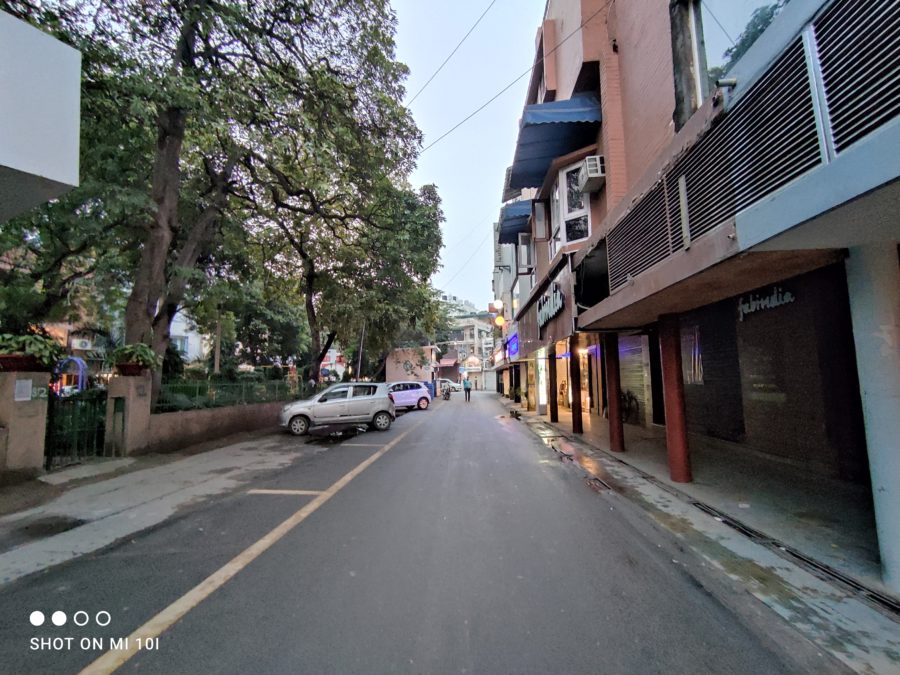There are many claimants to the crown, but Xiaomi has been the king of entry to mid-range smartphones in India for some time now. However, in 2020, the company started focusing more on brand differentiation and a more premium outlook.
Spinning off Redmi into its own entity, launching an array of excellent products in the Mi 10 series, and expanding its premium ecosystem offerings — Xiaomi wants to be seen as a legitimate high-end option and a credible alternative to OnePlus.
Enter the Xiaomi Mi 10i. While the Mi 10T and Mi 10 went up against the OnePlus 8T and OnePlus 8 Pro, respectively, Xiaomi’s latest battles the OnePlus Nord. This is the brand’s attempt to mark itself as a serious player in the sub-30,000 rupee market. But can a compelling hardware package beat the cleaner software experience offered by the OnePlus Nord? Read on and find out in Android Authority‘s Xiaomi Mi 10i review.
How’s the design of the Xiaomi Mi 10i?

The Xiaomi Mi 10i stands out from the rest of its Mi 10 series brethren with its unique design. Over at the back, the phone looks like a crossover between the Poco X3 and a bit of the classic OnePlus 7T, owing to the protruding circular camera module.
I tested the Pacific Sunset variant, which features a bold gradient. It flows from a brilliant cyan to an interesting mix of pink and orange. No matter your take on gradients, the color certainly comes out as striking.
Related: These are the best Xiaomi phones you can buy
The rest of the phone is relatively straightforward with well-positioned, tactile volume buttons, an IR blaster at the top, a USB-C port at the bottom, and a headphone jack. I appreciate the fact that Xiaomi has opted for a combination power button and fingerprint reader over an in-display sensor. It’s fast and just works.
The edges of the phone sit just a bit too harshly in the palm of the hand, unlike the exquisitely curved corners on the Mi 10. Additionally, its 214g weight is very noticeable. They can make the phone a bit of a chore to hold over longer durations.


Upfront, the design is a bit more straightforward. I like the choice of a flat display, but there’s much else to like here. The 6.67-inch Full HD panel is of the LCD variety. This might be a bit disappointing to some, but Xiaomi has made up for it with a 120Hz refresh rate.
Additionally, the variable refresh rate helps prevent unexpected battery drain. The screen supports six different refresh rate profiles. They scale all the way down to 30Hz for videos and run at a full-fat 120Hz in the interface, as well as in supported apps.
The 6.67-inch 120Hz panel supports six different adaptive refresh rate profiles.
I quite enjoyed the display on the Mi 10i. Media content looks excellent with great contrast levels. I did, however, miss the deep blacks afforded by AMOLED panels like the one on the OnePlus Nord. Additionally, maximum brightness levels aren’t quite as high as I’d have liked them to be. I can see this being an issue under direct sunlight.
Talking about multimedia content, the stereo speakers on the Mi 10i are quite impressive for the category. They lack the depth offered up by the speakers on the Mi 10, nor do they go as loud, but most users should be pleased by the output. They particularly shine when playing games.
The phone also has an IP53 rating for water resistance and the display is protected by Gorilla Glass 5.
How powerful is the Xiaomi Mi 10i?

The Mi 10i marks Xiaomi’s debut of the Qualcomm Snapdragon 750G chipset. Despite the lower status in the overall lineup, the chipset isn’t as much of a downgrade from the ubiquitous Snapdragon 765G as you might expect. You get two Cortex A77 cores clocked at 2.2GHz, in addition to six Cortex A55 cores running at up to 1.8GHz. The GPU has been downgraded to the Adreno 619, but real-world performance metrics were fairly on par.
This brings us to day-to-day performance. As is the case with practically every mid-range phone in this price range, Xiaomi has done an exemplary job at optimizing MIUI 12 for the hardware. The phone remains snappy in day-to-day operations. You can really see that extra bit of smoothness when scrolling around the interface with the display set to 120Hz. A word of caution, however. You’ll have to switch this on as by default the phone ships with the panel set to 60Hz.
Performance in daily use is perfectly acceptable, but the phone gets warm to the touch with gaming.
Gaming performance is where there’s a slight dip. Don’t get me wrong, the Xiaomi Mi 10i is perfectly capable of running all modern games with the graphics cranked up. Nevertheless, you might notice the occasional frame drop, and the phone definitely feels warm to the touch after long gaming sessions.
Additionally, the Snapdragon 750G brings 5G support to a whole new price point. The built-in x52 modem supports both sub-6GHz and mmWave 5G. Of course, this is a moot point in India where 5G still remains a pipedream, but the future-proofing is welcome.
What is the software like?
![]()
Over to the software side of things, it’s disappointing to see Xiaomi’s latest ship without Android 11 out of the box. Moreover, I’m going to sound like a broken record but Xiaomi really needs to sort out its bloatware problem. Sure, there are no ads here like other premium Mi phones, but that doesn’t mean there isn’t redundant clutter out of the box.
Facebook, WPS Office, pre-loaded shortcuts for games, and, especially, GetApps are a pain to deal with. The latter can’t be removed and clutters up the notification shade with spam.
Read more: Everything you need to know about MIUI 12
It’s not all bad, of course. We’ve covered the full list of changes in MIUI 12 already. There are a whole bunch of privacy features and interface tweaks that make it one of the better takes on Android.
Finally, if you prefer to use Alexa over Google Assistant, Xiaomi has baked in dual wake-word support into the phone.
Is the battery life on the Xiaomi Mi 10i any good?
The 4,820mAh cell in the Mi 10i is partly responsible for the heft of the phone, but I’m not complaining. In my time with the device, I could comfortably get through an entire day of use without triggering battery anxiety. This with the display set to 120Hz.
MIUI 12 has excellent battery optimization. The phone can easily last a day and a half on a single charge.
The adaptive resolution and Xiaomi’s software optimizations shine. Users should have absolutely no issue in getting at least one full day of use out of the phone, if not more. Charging is speedy too, with a 33W wired charger included in the box. The Mi 10i can be topped up to just short of 70% in 30 minutes, with a full charge taking about 70 minutes. There’s no wireless charging, but that’s to be expected at this price point.
Is the Xiaomi Mi 10i camera any good?

The bit that really sets the Mi 10i apart from anything else in the segment is its inclusion of a 108MP camera sensor. Previously the mainstay of higher-end hardware, it’s interesting to see the rapid commoditization of high-resolution sensors. Make no mistake, however, this is not quite the same sensor as the one on the Mi 10 or those found on Samsung’s top-tier phones.
The Samsung HM2 is a brand new 108MP sensor — one that its maker claims is the world’s smallest 108MP module. Additionally, you’ll find a ho-hum 8MP ultra-wide camera, as well as 2MP macro shooter, and a depth sensor. I don’t understand the insistence on the incredibly low-resolution macro sensors for the sake of a marketing checkbox, but here we are.

Overall image quality isn’t quite flagship-grade. It is clear that the 9-to-1 pixel binned output is of a lower-tier compared to the 108MP sensors on other phones. Xiaomi’s own Mi 10 and Mi 10T outshine the Mi 10i by a margin. In the shot above, there’s a good amount of center sharpness, but there is a noticeable amount of distortion towards the edges.


Xiaomi’s camera tuning also tends to err on the side of oversaturation. The colors are appealing and visually striking, but not quite true to life. I don’t expect this to be a problem for most users. The image output here is significantly better than most of the competition. In fact, it handily surpasses the camera setup on the OnePlus Nord.

I really like the wide 120-degree field of view offered by the 8MP sensor of the Mi 10i too. However, this comes with the downside of significant edge distortion. The 8MP resolution isn’t much to play around with. You’ll definitely want to stick to brightly lit settings for optimal results.


In dim lighting, the pixel-binned output is pretty decent all things considered. Nevertheless, there is still a bit of noise in the shadow region. Switch over to the dedicated night mode, and you should get a much brighter, crisper image.

The Macro mode captures reasonably detailed shots that look good enough on the phone’s display. Blown up to a large screen, it is easy to see the limitations of the low-resolution sensor. Colors definitely pop, but as is usually the case with Xiaomi phones, the picture here is a bit too bright. The highlights could be toned down just a smidgen too. It’s not the worst macro camera, but it’s far from the best.

The 16MP selfie camera on the Mi 10i does a decent job, but Xiaomi’s beautification modes are further amplified here. There’s just too much artificial smoothening at play even with the settings turned down. This might be great for social media aficionados, but if you’re looking for accuracy, this is not it.
Finally coming over to video quality, recording tops off at 4K 30FPS and the results are not particularly great. I found 2020’s Mi 10 to be one of the most capable Android smartphones as far as video quality is concerned, but the Mi 10i is a far cry from it. 4K video has the saturation bumped up, and I observed a warm overcast tone. Additionally, the lack of stabilization really hurts as panning around in the video leads to jerky frames.
What I like about the Xiaomi Mi 10i
- The design. Xiaomi has done a great job at creating a fairly distinctive phone. The choice of colors for the gradient catches the eye.
- The display. Sure, it’s an LCD panel but there are not too many 120Hz displays available at this price point. The inclusion of adaptive refresh rates is handy as well.
- The camera. Okay, this one is mostly applicable for the primary 108MP sensor, but the quality here outshines most of the competition.
- The battery life. The 4,820mAh battery mated to the highly optimized MIUI 12 ensures that the phone keeps on going. When it’s time to charge, 33W support is great to have.
What I dislike
- The choice of Android version. Yes, Xiaomi’s latest smartphone is still shipping with Android 10.
- The bloatware. MIUI 12, for all its progress, still packs way too much bloatware and notification spam.
- The macro camera. The 2MP macro camera has too low of a resolution and comes across as a token inclusion for marketing.
Specs
| Xiaomi Mi 10i | |
|---|---|
| Display | 6.67-in IPS LCD 20:9 aspect ratio, 120Hz Adaptive Refresh Rate Full HD+ 450nits |
| Processor | Qualcomm Snapdragon 750G Adreno 619 GPU |
| Memory | 6GB/8GB LPDDR5 RAM |
| Storage | 128GB UFS 2.2 |
| Battery | 4,820mAh 33W wired charging 33W charger in box Power delivery |
| Camera | Rear: Main: 108MP, f/1.8, 1/1.52-in sensor, Ultra-Wide: 8MP, f/2.2, 120-degree FoV Macro: 2MP, f/2.4 Depth: 2MP, f/2.4 Front: Selfie: 20MP f/2.3, in-display, 1/3.4-in sensor Video: 8K @30fps, 4K @60fps, 1080p @60fps, 720p @120fps |
| Dimensions | 6.51 x 3.02 x 0.35 in |
| Weight | 214.5g |
| Colors | Pacific Sunrise, Midnight Black, Atlantic Blue |
Xiaomi Mi 10i review: The verdict
The Xiaomi Mi 10i is a clear cut competitor for the OnePlus Nord. The phone challenges not just on the spec sheet but outpaces the OnePlus by undercutting it significantly on price. The OnePlus Nord is a great phone in its own right. Yet, for me, the camera setup on the Xiaomi Mi 10i gives it the edge.
Another alternative is the Samsung Galaxy M51, with its keen focus on battery life. The 7,000mAh battery outlasts practically everything else on the market. Additionally, the 6.7-inch AMOLED display in use is one of the better quality panels on the market.
Starting at Rs. 20,999 for the base variant with 6GB of RAM and 64GB storage, the Xiaomi Mi 10i is a phenomenal deal. It epitomizes the one thing that Xiaomi truly stands out for — value — without undercutting the increasingly premium identity of its Mi product line.
Even if you opt for the top-most variant, the Mi 10i is still more affordable than the OnePlus Nord. Moreover, it comes with a better camera, a bigger battery, and more distinctive styling. Bloatware aside, the Xiaomi Mi 10i is the company taking a laser focus on the segment and coming in guns blazing.
No comments:
Post a Comment